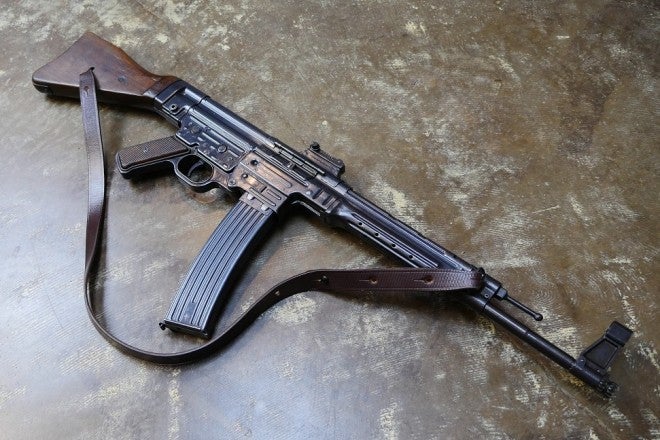In the early summer of this year, a car-full of gun nerds set out to capture the rare Pedersen rifle on camera for the first time. The passenger with the van Dyke mustache and ponytail had just mentioned how if he could own any machine gun, it would be an StG.44, the German assault rifle of the second World War. Upon this, the driver, a tall, blonde Texan in cowboy boots, rebounded that one of the other passengers was the only person he’s ever met who wasn’t impressed with the German ur-sturmgewehr, which caused a great deal of whiplash to the others as their heads spun around to look in surprise and incredulity at the overweight one with the unkempt beard and brown mop of hair.
It’s true, I’m “not impressed” with the MP.44, though that’s not to say that there are no elements of its design or history that I feel positively about. When he mentioned that, Alex surely had in mind my reaction upon seeing his MP.43-marked rifle displayed prominently at the front of his gun safe. My memory fails as to what it was, exactly, but it was probably something like a grunt. To some degree, my indifference towards the legendary Schmeisser assault rifle is due to me being a fairly contrarian person; something I see no point in denying or trying to hide. However, there are what I think are some very good reasons for lowering the pedestal we gun nerds have collectively put the MP.44 on, and they are as follows:
1. It Wasn’t The First (Not By A Long Shot)
One of the very first articles I ever wrote for this blog discussed the Sturmgewehr’s largely unknown predecessors, which hailed from around the world, including the United States and France. It’s definitely true that Nazi Germany was the first nation to enthusiastically embrace the assault rifle concept, but it was definitely not the first, or even fourth or fifth assault rifle ever developed. Most accomplished small arms designers of the period would have probably been aware of the concept, and certainly everyone involved in military small arms design would have been familiar with the basic problem it aimed to solve, and the numerous solutions that had been proposed up to that time.
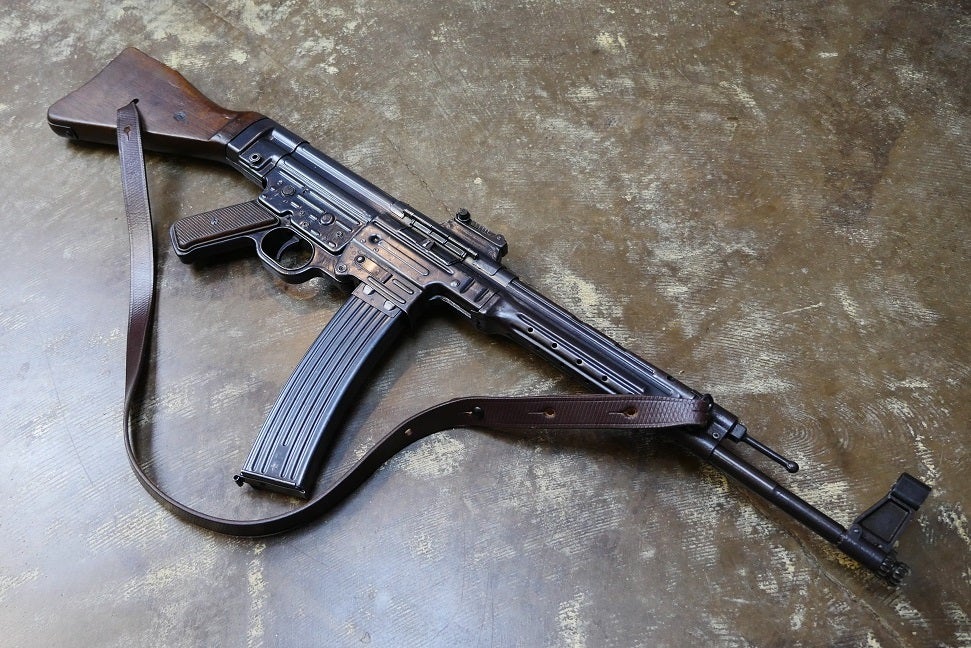
The StG-44 was an important step towards the universal adoption of the assault rifle concept for infantry weapons, but it wasn’t the first, or even fourth or fifth assault rifle ever. Thanks to Alex C. for the photo.
2. It Wasn’t Particularly Innovative
Besides being the first assault rifle made in very large numbers, there isn’t very much that the MP.44 can lay claim to having pioneered. Intermediate cartridges have been around essentially since the metallic cartridge case was invented, the weapon’s layout was well characterized and common by that point, and even stamping technology – although still in its infancy at the time – had been applied to many firearms by the early 1940s. Mechanically, even, the MP.44 is essentially just a ZB.26 turned upside down. Put together, these account for a certain degree of innovation, it’s true, but to hear some talk about it, the MP.44 changed firearms history forever. That’s really true only in a pedantic sense, as at best the MP.44 is an incarnation of a several existing concepts, albeit produced in impressive quantities for a country well on its way to losing a total war.
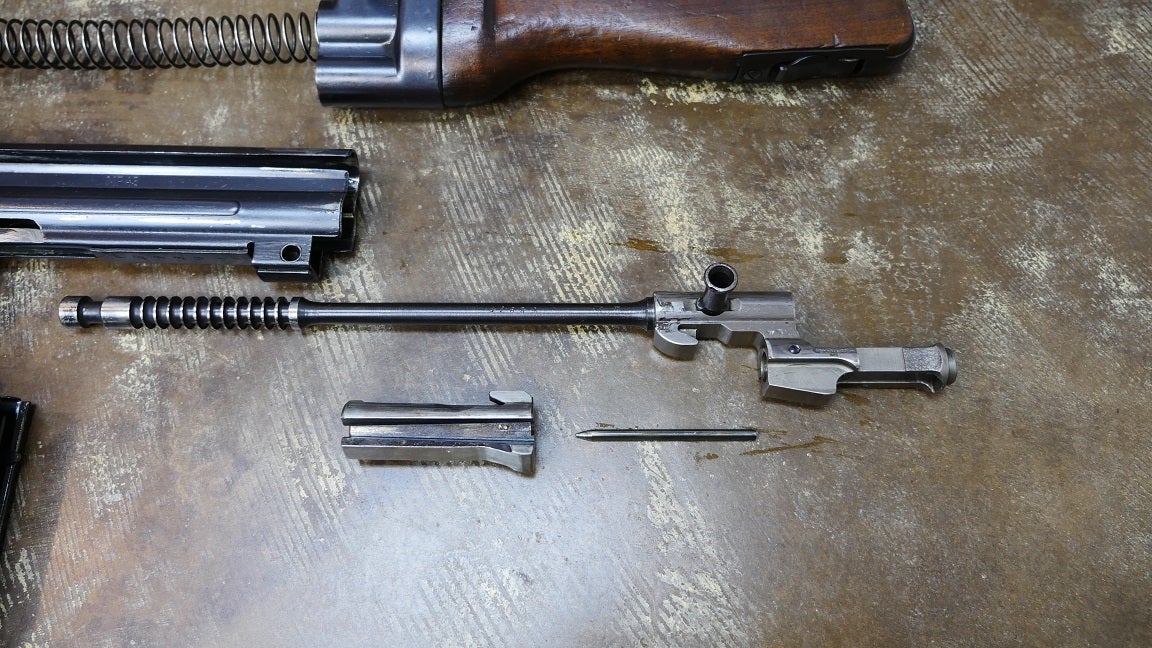
Taken as a whole, the MP.44 was an advanced weapon for the time period, but in detail it didn’t innovate very much. Here’s the bolt group, essentially copied from the Czech ZB.26. Thanks to Alex C. for the photo.
3. Its Ammunition Is A Lot Weaker And Not Any Lighter
One of the major advantages of the assault rifle concept is the reduction in ammunition weight. A rifleman armed with an M16 can carry twice as many rounds of ammunition as one armed with an M14, for the same load. You will hear this touted as a major advantage of the sturmgewehr-armed German soldier of WWII; he who can shoot more can effect the battlespace more, and is more likely to win.
But is the MP.44’s ammunition any lighter? The answer is surprising. A round of Krz.Ptr.43 ammunition for the MP.44 is only 17.05 grams, according to a Polte drawing. This is only 63% of what a round of .30 Cal. M2 AP weighs, according to my scale which reads 27.1 grams. That is not the final word, though, as en blocs and magazines must also be accounted for. An 8-round M1 en-bloc clip weighs 25 grams. In contrast, a 30-round MP.44 magazine weighs about 395 grams. Therefore, a loaded en-bloc clip of M2 AP weighs 241.8 grams, while a loaded MP.44 magazine of Kz.Ptr.43 weighs 906.5 grams.
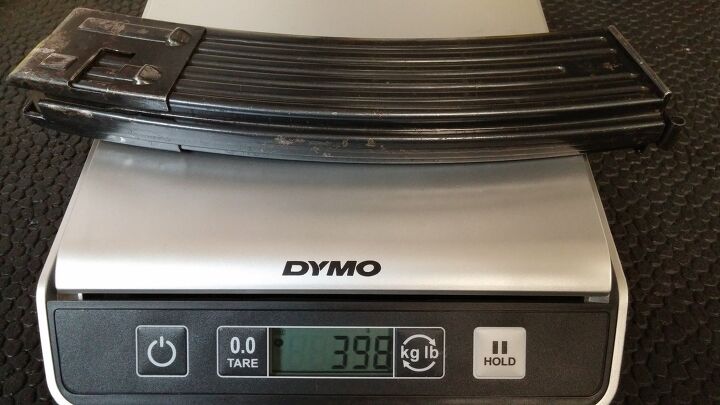
This blued MP.44 magazine weighs 398 grams; quite heavy! A parkerized mag weighed in the same session clocked 392 grams.
To put that in equal terms, then, thirty 8-round en-bloc clips of .30 M2 AP together weigh 7.254 kg; eight 30-round magazines of Kz.Ptr.43 weigh 7.252 kg. So much for the idea that the Sturmgewehr had lighter ammunition!
In practice, then, the MP.44-armed soldat could not carry any more ammunition than the M1-armed US GI; therefore the MP.44 is probably better viewed as trading bulk, power, and range for controllable fully automatic ability, vs. the M1. Which brings me to…
4. Full Auto Probably Didn’t Count For Much
It’s quite impressive to imagine German soldiers blazing away at their enemies with fully automatic weapons, but the postwar experience has shown that even controllable fully automatic weapons are much less useful than previously thought. Certainly, the infantry squad needs fully automatic weapons, and certainly there is a call for assault rifles as infantry weapons, particularly to help in certain situations, such as ambushes. However, many feel that the fully automatic capability of the MP.44 put into the hands of every soldier in the squad totally changed the game of infantry combat in World War II, and that’s probably not the case. I wouldn’t go so far as to say that the MP.44 shouldn’t have been select-fire, or that the fully automatic fire mode gave no advantage, but I also do not think the stumgewehr-armed German infantry squad was at such a massive advantage in firepower as to make any difference in the war. I reject the idea that, had the MP.44 appeared a couple of years earlier, the Allies would have had any more trouble winning the war. Most likely, they probably would have hardly noticed.
5. Most Of Them Were Dead Weight
A great deal of the Nazi war materiel was found in warehouses and depots, undelivered and unused. It’s very likely that the MP.44 granddad brought back from the war and registered was one of these; it probably wasn’t pried from the cold, dead hands of a slain SS officer. Many of these captured rifles were subsequently shipped off by the Allies to the Middle East or Africa to arm new post-colonial governments in those regions (and they still turn up there to this day). German industry also had a very hard time making enough ammunition and magazines for the guns, which likely further reduced the utility of fully automatic fire, as all but the best equipped soldiers would find their ammunition supplies dwindling quickly if the rifle was used as a submachine gun too often.
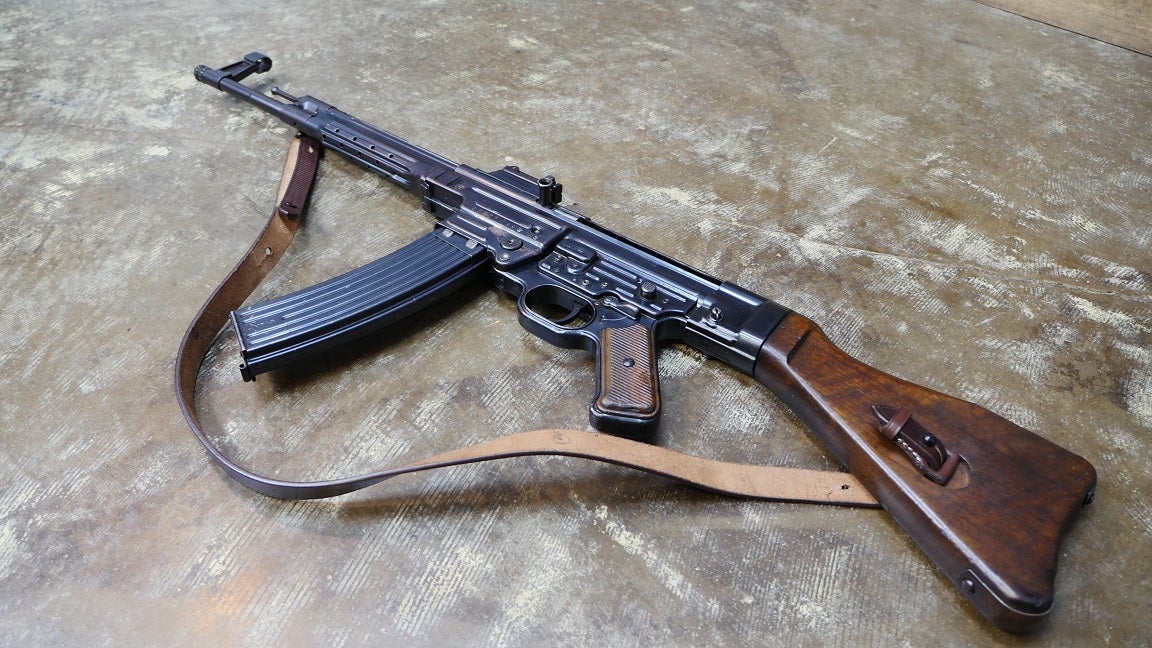
This MP.43-marked rifle is in excellent condition – almost like it was never issued. We may never know the history of this gun, but most MP.44s encountered on the Western Front were captured unissued from stockpiles. Thanks to Alex C. for the photo.
6. It Was A Byproduct Of A Failing System
Closely related to the last, this point relies on a lot of additional context regarding German industry during the war. The Nazis are often portrayed as having at their disposal a war machine of unparalleled power and capacity, but history paints a different picture. The Nazi economy was a mess, and the Germans struggled the entire war to maintain a competitive output of war materiel. One major reason for this was the funding of countless harebrained projects that should have been rejected out-of-hand, such as the useless, 188-tonne Maus heavy tank. In effect, if not in intent, the Nazis adopted a “shotgun” approach to development: Fund everything and see what sticks. It’s not so surprising, in that context, that it was the Nazis who first took the plunge and adopted an assault rifle as standard issue. The project started out the same way that any of the many useless, superfluous Nazi programs did, but incidentally proved to be a good idea, and took off from there. The adoption of the MP.44 as a standard arm for Nazi Germany is on close inspection one more piece of evidence for the deep systematic problems that nation had at effectively fighting a war of economy.
7. It Was Less Influential Than You Think
It’s easy to think that the Sturmgewehr kicked off a revolution in small arms. It was, after all, an early example of the type that is the standard model for infantry rifles today. The response to the MP.44 was, however, surprisingly conservative. Even the Soviets, who adopted the assault rifle concept most quickly after the Germans, continued to develop and issue other kinds of infantry rifles for many years afterward, indicating a certain level of reluctance to fully embrace it. This makes sense, as the need for rifles to reach out to greater distances than is practical for an early assault rifle was still strong in living memory. It would be wrong to say that the MP.44 sparked no interest at all, of course; many designers leapt to their drawing boards to design analogues, in many cases even retaining the original German caliber. However, despite that interest among the design firms and idea men of the world, military leadership did not initially cotton to the idea very much. It’s worth noting, as well, that in the West the assault rifle only really took off once the primary flaws expressed in the MP.44 had been worked out, through lighter weight ammunition and magazines.
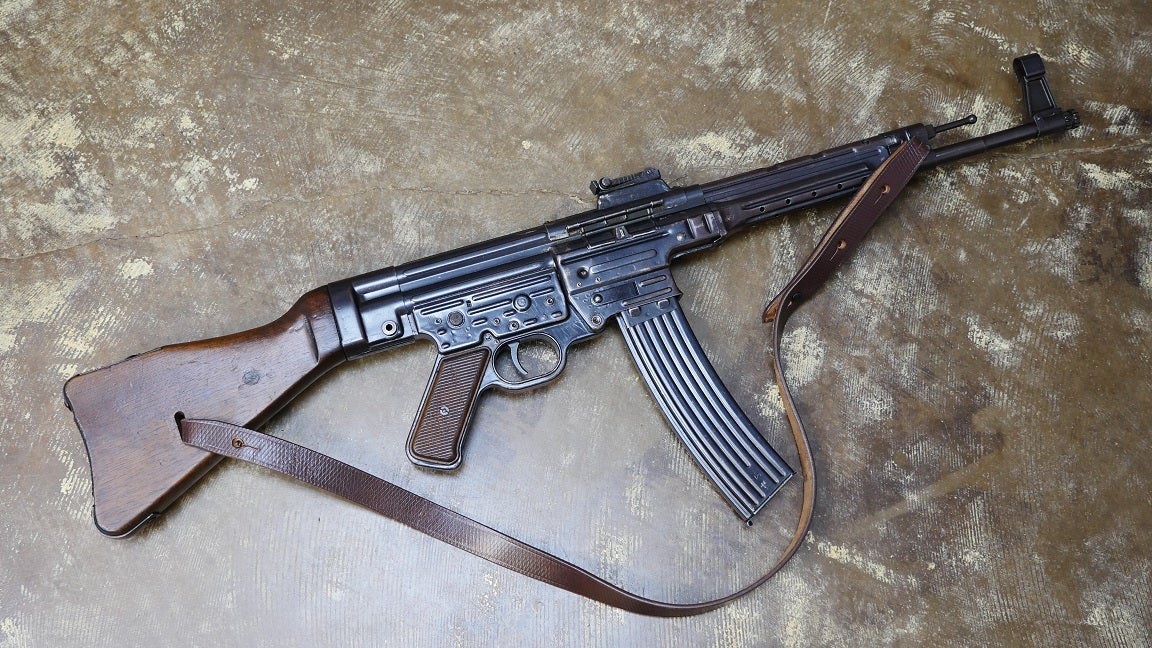
The MP.44 strikes a distinctive silhouette that is now familiar to anyone with an interest in military arms. However, after the war most military officers in charge of procurement – especially those in the West – still favored the older style of arm. Thanks to Alex C. for the photo.
To Conclude
All this is not to say that the MP.44 was a bad weapon, or that it was not noteworthy, but rather that it has in my opinion received something of an inflated reputation. None of these things, individually or together, mean that we shouldn’t be interested by the rifle, or that we shouldn’t like it. Instead, I think the MP.44’s status as a key development in small arms history is not as well-warranted as is widely thought, and a more sober perspective towards it is most appropriate.
 Your Privacy Choices
Your Privacy Choices
